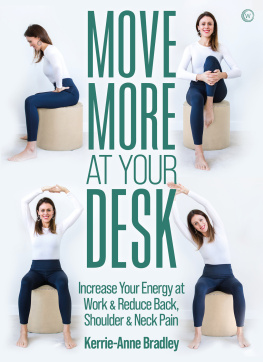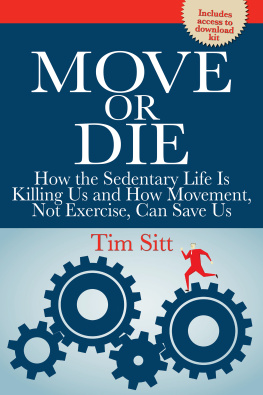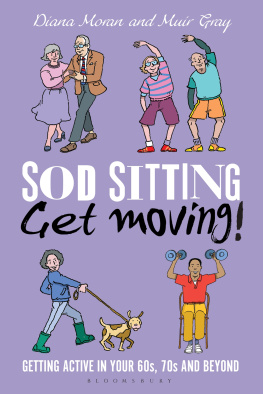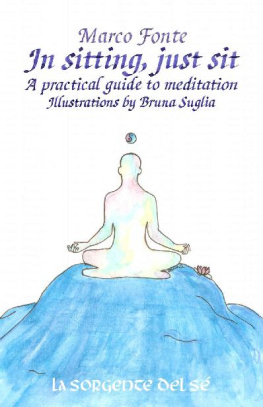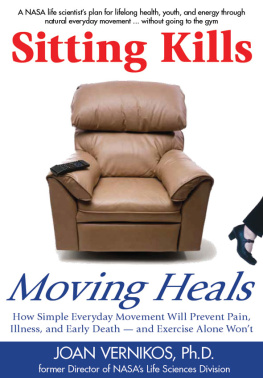DESIGNED TO MOVE
The Science-Backed Program to Fight
Sitting Disease and Enjoy Lifelong Health
Joan Vernikos

Designed to Move: The Science-Backed Program to
Fight Sitting Disease and Enjoy Lifelong Health
Copyright 2016 by Joan Vernikos. All rights reserved.
Cover image Vitruvian man courtesy vitstudio (Adobe Stock Photos)
Published by Quill Driver Books
An imprint of Linden Publishing
2006 South Mary Street, Fresno, California 93721
(559) 233-6633 / (800) 345-4447
QuillDriverBooks.com
Quill Driver Books and Colophon are trademarks of
Linden Publishing, Inc.
ISBN 978-1-61035-271-0
135798642
Printed in the United States of America
on acid-free paper.
Library of Congress Cataloging-in-Publication Data on file.
This book is dedicated to the magnificent John Glenn: hero, astronaut, U.S. senator, and, most of all, a wonderful human being.
Contents
Part Two: How to Enjoy Lifelong Health Through
Smart and Frequent Movement
Introduction
Throughout my fifty-five years in the space business, I was regularly asked about how we could send humans to live on Mars. How would our ancient genes fare in deep space and on foreign planets? The question is not much different here on Earth. How can we humans, with our ancestral genes, thrive in todays or tomorrows technology-modified environment?
My research at NASA was devoted to keeping astronauts healthy. Their bodies go through changes as they respond and seek to adapt to living in the microgravity of space. The research revealed unexpected clues to just how crucial gravity is to all of us living here on Earth. Plants need gravity to thrive, as do birds and bees to fly and navigate. Yet we humans generally ignore gravity. Yes, we know its all around us, but so what? Medical texts never mention it. If asked, we think of gravity as the enemy that drags us down and ages us. But I found that gravity is undoubtedly our friend, if only we would use it.
While I was speaking to audiences of all ages and writing The G-Connection: Harness Gravity and Reverse Aging (2004) and later Sitting Kills, Moving Heals (2011), new questions came up. I realized that I was sittingexcuse the punon a goldmine of information that could literally help millions live healthier, and therefore happier, longer lives in our ever-accelerating modern technology-rich society. Some of these technologies and medical advances help us live longer. But are we healthier? I therefore felt an urgency to share my knowledge and ideas based on new questions and data that may help you adjust and thrive in this fast-moving age. Designed to Move summarizes these new concepts in an effective but different way from the traditional pills, diet, and exercise commonly used as the solution to our ills.
Since I wrote Sitting Kills, Moving Heals, more information has been published about the hazards of sitting. Mostly this is based on metadata analyses and statistical surveys of existing epidemiological information, all linking our sedentary behavior to most modern disorders. This new evidence on the disastrous consequences of the hours we spend sitting has fueled huge social concern. Reliable research studies are rare. Effective solutions are even harder to find. It seemed obvious to me that the root of this social problem is that we just dont move much any more.
Move is a very interesting word. If you are not moving, you may be taken for dead. Whether verb or noun, this ancient word is loaded with life. It is equivalent to energy. The Oxford English Dictionary traces its origins to the ancient French mouvoir and the Latin movere. It has come to mean a lot of things. Appearing in the fifteenth century in reference to chess, it was later associated with moving furniture or relocating to a house or making a strategic move; it may be as practical as digesting, or having a bowel movement or a racing heart rate. A book, poem, or admirer may be deeply moving, invoking the inner stirrings of emotion. Essentially, moving is defined as a change in position, whether internal, external, or emotional.
Movelessness, then, is what you do when sitting. It involves minimal motion. He is not moving is taken to mean someone is not in any form of action, is lifeless, without energy or dead. Considering moving in all its variations is essential to understanding life. Communicating the pivotal role of moving in staying healthy and alive is this books message.
Designed to Move is for those who want to regain control over their long-term health and well-being with a natural solution. I wrote it to bring you up to speed on the latest research from NASA and the scientific community on the physiological benefits of moving and to offer workable solutions for using gravity, our ever-present friend, to strengthen your body and improve your life. As we struggle to find the best ways to help astronauts explore and live on Mars one day, why not at the same time choose to live well on Earth? This book shows you how.
PART ONE
ASTRONAUTS,
AGING, AND SITTING
Chapter 1
Gravity Gets You Moving
As we progress through life in todays society, we become more and more sedentary. We call the changes aging, as if they are natural and unavoidable. It does not have to be that way. Our genes may predispose but how healthy your aging might be is at your disposal. Learning how to live in gravity is what children do as they learn to move in the earliest months and years of life. Relearning how to live in gravity as an adult is what this book is all about. Gravity is more than our friendit is our lifeline.
In 1964, I was hired by the National Aeronautics and Space Administration (NASA) as a postdoctoral fellow. My job was to help NASA conduct research on stress and how astronauts could cope with the rigors of traveling into outer space and back to Earth. This was three years after the first human (Soviet cosmonaut Yuri Gagarin) had flown into space, an event that prompted U.S. president John F. Kennedy to issue the famous challenge to put a man on the moon by the end of the decade. Though I held a Ph.D. from a highly regarded medical school, I knew nothing about how travel in outer space might affect the human body, and neither did anyone else. In my medical research I had plenty of experience measuring stress in humans under a variety of conditions. My research specialty involved developing new and better ways of measuring the hormone response to stress and discovering how the brain was involved in that response. One thing that seemed clear to NASA and everyone else was that putting humans on top of a rocket and blasting them into space had to be stressful. It was therefore logical that the small team of five scientists who formed the first core of NASAs research group at the Ames Research Center in California should include a person with my background as their stress researcher.
And so it was that I came to have access to the hormone data from samples obtained from astronauts Frank Borman and Jim Lovell before, during, and after the historic fourteen-day Gemini 7 space mission in 1965, the longest manned space flight at that time. Though we found, as we had in previous flights, sizeable increases in stress hormones like cortisol before launch and after landing fourteen days later, this was the first time we had the opportunity to measure stress hormones daily throughout the astronauts actual stay in space.




